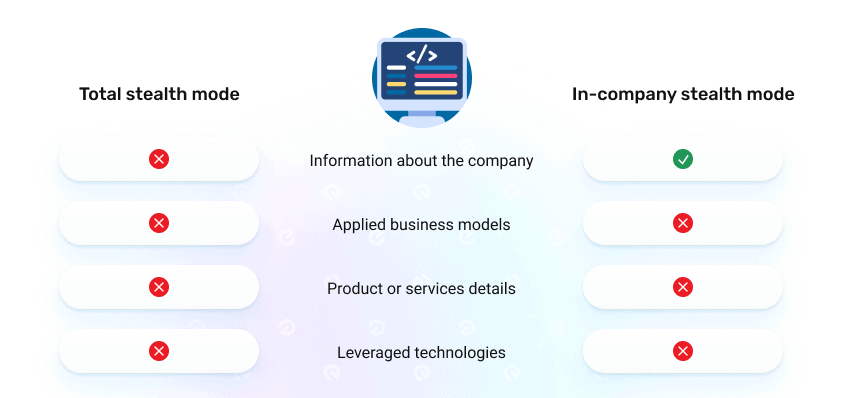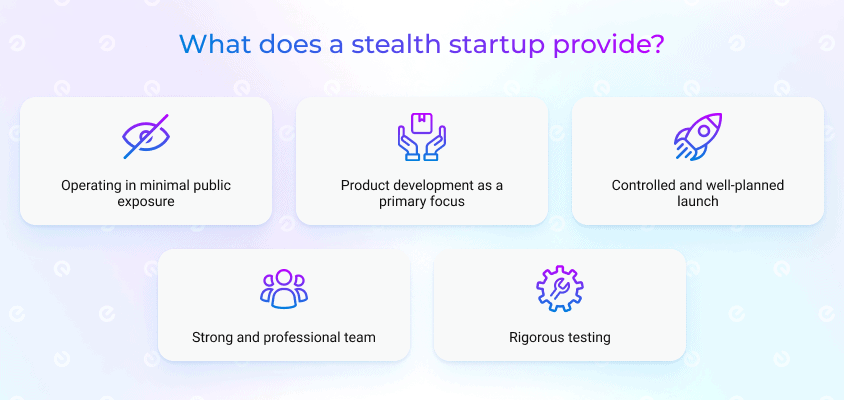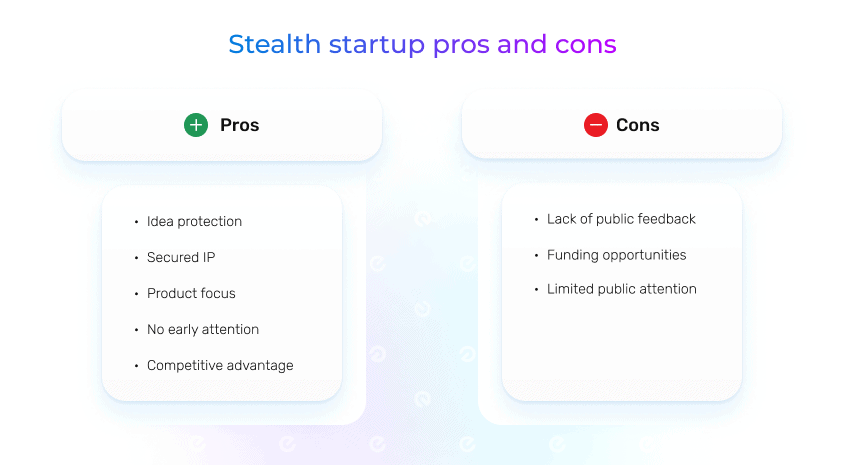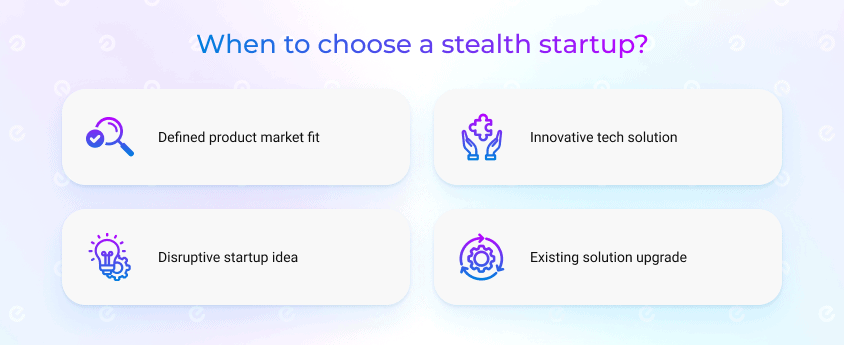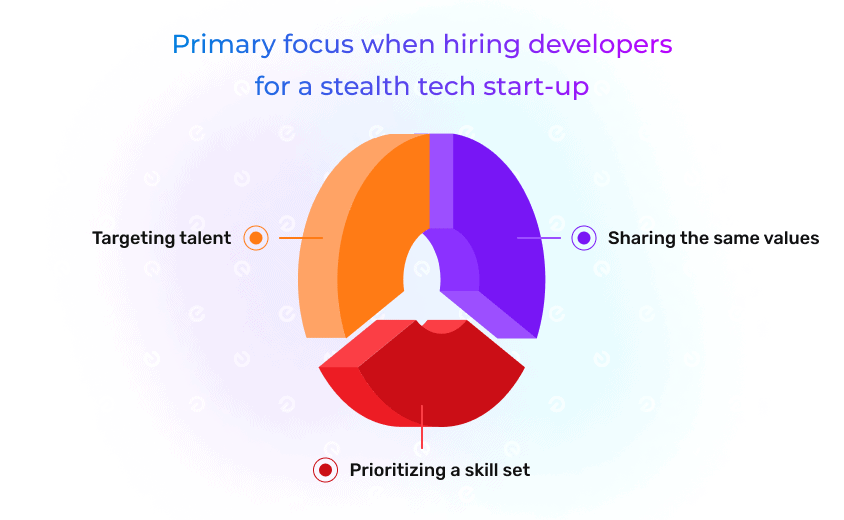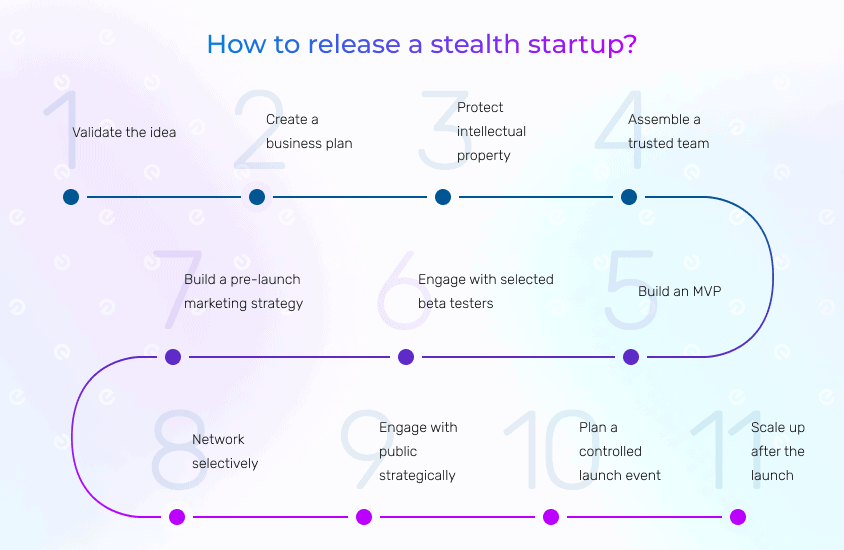
Updated: May 10, 2024
Published: August 16, 2023
How to launch a successful startup when the market gets so competitive? What effective strategies could be leveraged? What is your well-matched type of startup? In this article, we’d like to focus on a stealth startup, how it differs from a regular one, and why some businesses prefer it.
List of the Content
- What is a stealth startup?
- What does a stealth startup mean for businesses?
- Stealth startup pros and cons
- When to consider launching a stealth-mode startup?
- How to hire developers for a stealth tech startup?
- How to release a stealth startup?
- Conclusion
WHAT IS A STEALTH STARTUP?
Talking about the startup world, the primary focus is often shifted to gaining wide recognition. The blaze of publicity is used to attract customers and investors. Startups with bright new ideas seek publicity to spread the word about their products and services. But how come some choose to operate in stealth mode?
The primary goal of a stealth startup is to maintain confidentiality and avoid attracting attention from competitors, potential customers, and the media until they are ready to make a big splash in the market.
What is a stealth startup?
Stealth startups are businesses operating in some degree of secrecy and minimal public exposure. The company decides to keep details about the company’s product, technology, business model, and even its existence away from the public eye.
Typically, a stealth startup may share limited information with a select group of investors, partners, and advisors who have signed non-disclosure agreements (NDAs). As the startup reaches a more mature stage, it eventually “comes out of stealth mode” and begins actively promoting its product or service to the broader public, generating interest and officially launching in the market. At this point, the company starts to engage with the media, attend conferences, and take a more public-facing approach.
Actually, the idea of keeping the startup in stealth mode might have some compelling reasons. It is a great option whether the company wants to protect the product idea or avoid distraction from the public, especially when working on new advancements in their domain. Even the original idea of keeping something in secret could add to the success of the evolving startup. Companies have the opportunity to unveil the full potential of new products or services when they only find it necessary.
The next aspect is that these startups go with limiting information not only about the idea but their company and business operations in general. Any details aren’t publicly available and only disclosed within NDAs with agreed parties. What’s more, the stealth startup can be specified into some categories:
- Total stealth mode – This type of startup differentiates itself by absolute secrecy. No information about the company can be found publicly. Such businesses won’t have a website or even a public profile somewhere. They choose to maintain the utmost secrecy until the launch.
- In-company stealth mode – It often refers to the existing companies that create new products in secret. Often they prefer to use code or alternative names not to unveil the real goal of their startup.
Even though some strategies remain trending, they’re still worth considering. The awareness of different approaches allows the business to come up with the best suitable solutions. Some may even consider a stealth startup a controversial approach though they don’t deny that it has become a smart strategy for many startups. The main thing is to figure out how effective it is for your business-specific case.
WHAT DOES A STEALTH STARTUP MEAN FOR BUSINESSES?
The key difference from a regular startup is that the stealth mode can be a strategic approach for certain companies looking to develop disruptive products or services while keeping their plans hidden from competitors and the public until the right moment.
In the context of business, it refers to a period when a company operates in secret or with limited public visibility, typically to develop a product, service, or technology without drawing attention from competitors, customers, or the media. This approach is often taken by startups or companies working on innovative and disruptive ideas.
Businesses are eager to take the most out of this period and put their efforts into reaching the best results. The stealth mode helps draw the most focus to product development and gain market interest when it’s planned. Regardless of the industry, many companies succeed in using this time for better functionality, product presentation, and future perspectives. Of course, it can be conducted effectively due to meticulous and strategic planning and well-outlined implementation.
Let’s focus on some major reasons for being a stealth startup for businesses.
- It’s about prioritizing confidentiality and keeping the product or service development, business strategy, and other critical information hidden from the public and competitors. The purpose is to protect their intellectual property and avoid potential copycats or competitors entering the market before they are fully prepared.
- The stealth mode helps concentrate on product development without the pressure of public scrutiny. This allows teams to iterate and improve their products or services without external interference.
- These startups have a different approach to maintaining a competitive advantage. They choose the opportunity to fine-tune their products, conduct rigorous testing, and respond to feedback before the public or competitors are aware of their offerings.
- Being stealthy can build up curiosity and anticipation for the company’s eventual launch. Startups may create a sense of mystery and excitement, which can be beneficial for branding and marketing efforts when the time comes to reveal their products or services.
- Operating in stealth mode can attract a team of highly motivated and skilled individuals that are excited about working on something innovative and potentially groundbreaking.
- The stealth approach allows startups to plan and execute a well-prepared and controlled launch once they are ready to enter the market. That can create a more significant impact and attract greater attention from potential customers, investors, etc.
The decision to operate as a stealth startup depends on the specific circumstances, industry, and product/service being developed. While the approach offers certain advantages, it also requires detailed planning and execution to ensure success when the time comes to break the silence and enter the market. The company takes the most of this period and presents their product in the right light. Besides, it involves leveraging the right marketing strategies to cover other related aspects.
STEALTH STARTUP PROS AND CONS
Why choose a stealth startup? That is the apparent question we’d like to figure out and explain its gain in popularity. In fact, any company somehow starts in stealth mode, especially considering the period everyone spends thinking about the startup implementation and only then announcing it to the public. At the same time, others prefer to make this stage longer and approach it strategically.
Therefore, focusing on the pros and cons could help to better understand this approach. Operating in stealth mode offers several benefits for startups, depending on their specific requirements and goals. Some of the key advantages include:
- Idea protection: By keeping details of their technology, product, or business model under wraps, startups can protect innovative ideas from being copied or stolen by others. Competitors cannot respond effectively to a startup that they are unaware of. That minimizes the risk of adapting their strategies, copying features, or launching similar products in response to the startup’s activities.
- Secured IP: One of the primary benefits of operating in stealth mode is that it allows a startup to maintain control over its intellectual property and proprietary technology. By keeping their innovations and ideas hidden from competitors and potential copycats, startups can work on building a strong foundation of IP without the risk of premature exposure.
- Product focus: The stealth startup company dedicates its energy and resources to product development, testing, and iteration without the pressures of public expectations. That allows for a more focused and iterative development process, leading to a higher-quality end product.
- No early attention: If a startup announces its concept or idea too early, it might attract attention, hype, and speculation from competitors, investors, and the media. That can lead to increased scrutiny, premature comparisons, and even potential attempts to replicate or undermine the idea. Teams could avoid many distractions and focus on refining the evolving product or service.
- Competitive advantage: Operating in stealth mode enables a startup to maintain a first-mover advantage. It means that when the startup finally launches its product or service, it can capture a significant portion of the market share and establish itself as a leader in its niche before competitors can catch up.
Of course, these great advantages are worth special attention. But like any other approach, we need to discover from different perspectives and check its drawbacks.
- Lack of public feedback: Without public exposure, startups might struggle to gather early feedback and validate their product or service demand. Without an efficient strategy, it can lead to a situation where the startup invests significant resources into a product that ultimately doesn’t resonate with the target audience. When a startup finally exits stealth mode, it needs to manage public relations effectively to ensure the successful adoption of products or services.
- Funding opportunities: By keeping their activities secretive, startups might miss out on valuable networking and partnership opportunities. Building relationships with potential collaborators, investors, and industry experts can be more challenging when the startup’s activities are concealed. Some investors prefer transparency and a clear understanding of the startup’s progress and direction. Operating in stealth mode might make it harder to attract investors who want to see tangible evidence of a startup’s potential and growth.
- Limited public attention: That has become an advantage and a drawback at the same time. The disadvantage is related to the fact that the startup’s brand and product are not exposed to the public during the development phase. That can make it challenging to build brand awareness and generate anticipation among potential customers, which is crucial for a successful launch.
Therefore, it’s important to note that stealth mode is not suitable for all startups, as there are also potential downsides, such as difficulty in attracting investors, challenges in building early brand awareness, and the risk of overextending the secret phase and missing out on market opportunities. Each startup should carefully consider its goals, resources, and market conditions before operating in stealth mode. And if they go with this approach, they need to learn how to leverage all the mentioned advantages.
WHEN TO CONSIDER LAUNCHING A STEALTH STARTUP?
So what are common cases for selecting this type of startup? Many would like to get a straight answer here, but it isn’t as easy as it seems at first sight. Every team has to conduct comprehensive research and analysis of their needs. And only after considering all the project specifications, it’s possible to make deliberate decisions.
The other thing to remember is that any startup is not without risk. Covering other perspectives, stealth startups could really hold a lot of appeal. They tend to provide different opportunities to be turned to the business advantage when properly addressed. The option of releasing a stealth startup might suit the project that falls into one of the following categories.
Have a clear understanding of the product market fit
Knowing and understanding the product-market fit is crucial for the success of any product or business. That refers to the alignment between the product or service and the needs, preferences, and demands of your target market. It’s about creating something that resonates with your customers and provides them with value in a way that competitors cannot easily replicate. With a stealth startup, you definitely need to know your target market, as there aren’t options for gathering feedback and building relations with your customers before the launch. The company has to present a full-fledged product to get the target audience right away. The challenge is that the company only relies on presumptions and insights from the conducted analysis.
Create an innovative technology solution
Keeping the technology under wrap allows the team to develop a substantial lead in terms of innovation and product development. When they eventually launch, they can introduce a technology that is more advanced and differentiated, giving them a competitive edge in the market. That also helps businesses to keep the technology and innovative ideas hidden from competitors, potential copycats, and patent trolls. Besides, it’s a great opportunity for new market players as they can take their time and effort before entering the market. Compared with known aggregators, they have much more available resources and can release a similar solution much faster.
Have a truly disruptive startup idea
The idea value is a really decisive aspect of this type of startup. There is not much point in developing something in stealth mode when the market has a variety of similar alternatives. The stealth-mode projects are all about disruptive products or services offering something different or completely new to the market. As long as turning this idea into reality takes time, dedication, and perseverance, the stealth mode can contribute extensively to this case. Moreover, public exposure doesn’t always work best at the early stages of product development.
Need an upgrade to an existing solution
It might seem controversial but often reasonable for many teams. Even being known in the market, there will be cases with a need to keep some plans private and surprise customers with new solutions. Many companies found it effective to make the product or service launch a good starting point for new business opportunities. Balancing the secrecy to improve existing solutions and gather feedback is crucial to success. It’s one of the strategic approaches to generate curiosity and anticipation in the market. That definitely ensures a more engaged and interested audience while managing its rising expectations.
HOW TO HIRE DEVELOPERS WHEN THE TECH STARTUP IS IN STEALTH MODE?
Even though confidentiality turns out to be the main advantage of stealth-mode startups, it often poses particular challenges to finding experts to join the team. With a great idea behind the product, there is always a need to set up a professional team unless you already have one.
In most cases, startups are new market representatives starting a business from scratch. They commonly target talented specialists to join their teams. Especially with tech startups, it’s not necessarily that founders have to be developers. They need to find the right experts and set up a dedicated development team to implement the outlined solutions. So what are useful tips for hiring the team when operating in stealth mode? And most importantly, how to make this process less challenging?
Targeting talent
Evolving innovative products definitely requires talented experts. Their experience would always bring additional value to the project. Regular startups have better opportunities to attract specialists due to the commonly generated buzz around them. At the same time, stealth-mode startups choose the opposite way. This challenge is related to the need to handle the entire process confidentially.
The hiring practice often relies upon research and targeting required specialists. The compelling difference is that the company has to approach candidates themselves as they can’t find any information about your startup. It’s important to include the project context without specific details, reasons to join your team, how they can thrive within your organization, etc.
Prioritizing a skill set
The company’s primary task is clearly outlining the roles and skills they need for a startup. Whether front-end, back-end, full-stack, or specialized developers, having a well-defined job description will help select the right candidates. Also, create a compelling vision for your startup that you can share with potential hires, even if you can’t reveal many details. Besides, all the candidates have to sign NDAs and confidentiality agreements before discussing specific project details. When technical skills are important, evaluating a candidate’s potential to learn, adapt, and collaborate is equally crucial. Using different evaluation methods can give you a comprehensive understanding of a candidate’s skill set and suitability for the role and your company.
Sharing the same values
Considering all the specifications of the stealth startup, it’s important to create a strong team sharing the same vision. The point is that it helps to maintain the product focus and build a cohesive work environment. As a result, it supports smoother collaboration, effective communication, and a stronger sense of unity.
Moreover, the stealth startup doesn’t need to hire many specialists immediately. It’s more about gathering like-minded people ready to work towards a similar goal. The right combination of their experience and motivation helps to build and scale your project step by step. There’s no need to compromise here, as the company needs a reliable and professional team to handle the entire process from scratch.
Looking for skilled developers to join your team?
Get engaged with Existek’s professionals. Our software development company is ready to share our first-hand experience and provide skilled talents to meet your needs under NDA.
HOW TO RELEASE A STEALTH STARTUP?
Releasing a stealth startup involves launching the company and products while maintaining a low profile and avoiding extensive public attention until they’re ready for a grander reveal. This approach is often taken to protect intellectual property, stay under the radar of competitors, or avoid premature scrutiny from the market. Here’s a step-by-step guide on how to release a stealth tech startup:
Validate the idea
Before going stealth, ensure that the software product or service has potential in the market. At this stage, the team focuses on the idea implementation, conducts market research, gathers feedback from potential customers, and makes necessary improvements.
Create a solid business plan
It’s an essential step to develop a comprehensive business plan outlining the target market, value proposition, revenue model, marketing strategy, and financial projections. Having a clear roadmap will guide the stealth launch and future growth.
Register the company and protect intellectual property
It’s time to formally establish the business by registering it as a legal entity if not registered yet. Additionally, protect any intellectual property, such as trademarks, patents, or copyrights, that may be crucial to the startup’s success.
Assemble a trusted team
Like any other project, the company has to gather a team of skilled individuals who share the same vision and can maintain confidentiality. Ensure that everyone signs non-disclosure agreements to protect sensitive information.
Build an MVP
The team commonly starts with developing a basic product version that showcases its core functionalities. This will help test the concept and gather valuable feedback from early adopters while maintaining secrecy.
Engage with a select group of beta testers
The business might also invite a small group of trusted individuals or potential customers to beta-test the product. This allows them to gather feedback, identify and fix bugs, and iterate on the product without attracting much attention.
Build a pre-launch marketing strategy
Develop a marketing plan to create buzz around the product without revealing too much about the startup itself. Use social media, blogs, and industry forums to tease the product and attract early adopters.
Network selectively
It is recommended to attend industry events, conferences, and meetups selectively without divulging too many details about the startup. It’s about using these opportunities to gather insights and build strategic partnerships discreetly.
Engage with press and influencers strategically
The company also connects with journalists and influencers who specialize in their industry and share just enough information to pique their interest. This may lead to pre-launch coverage without revealing everything.
Plan a controlled launch event
When you’re ready to come out of stealth mode, organize a well-coordinated launch event that introduces the startup and product to a wider audience. Utilize available connections and earlier marketing efforts to generate buzz during the launch.
Scale up after the launch
After the successful release, the business can gradually expand marketing efforts, increase the team, and seek additional funding if necessary. Remember, releasing a stealth startup requires a delicate balance between secrecy and generating interest. Keep the focus on the product’s unique value proposition and the team’s capabilities while preserving the element of surprise until the right moment.
Finding out these details helps to realize that stealth-mode startups undergo similar evolving stages with one distinct difference behind them. The entire process has to be handled in secrecy and with minimal public exposure following stealth mode specifications.
CONCLUSION
When the market is full of different options to approach releasing startups, it might be hard to define your one right away. The best idea is to research the market and learn its good practices. The startup world attracts more and more competitors due to plenty of opportunities. Though the way you’d like to enter it depends just on your vision.
We hope you’ve gained all the necessary insights on the stealth startup and know how to make it align with your internal needs. Make sure to conduct detailed research to determine which approach works best for your idea implementation.
Need a professional consultation?
Feel free to contact Existek. Our team of experts knows how to address the needs of both well-established representatives and new market players. We’re ready to assist you with building sophisticated software while winning the market competition.
Frequently asked questions
What does a stealth startup mean?
The company operates in stealth mode to avoid public attention and competition, often keeping details hidden from the public, investors, and competitors until it's ready to make a significant impact or launch its product. This approach is often used to maintain a competitive advantage and control the narrative around the startup's offerings.
What are the distinct advantages of a stealth-mode startup?
The great thing about operating startups in stealth mode is that the company can obtain the following benefits:
- Idea protection
- Secured IP
- Product focus
- No early attention
- Competitive advantage
How to hire developers for a stealth startup?
The company has to begin by clearly outlining the roles they require. It's recommended to connect with potential candidates and highlight the confidential nature of the project. As long as the team effectively conveys the startup's vision and long-term aspirations during the hiring process, they gain the opportunity to attract developers who are both skilled and enthusiastic about joining their journey.
How to successfully launch a stealth startup?
Launching a stealth startup involves maintaining secrecy about your business idea and operations until you're ready to make a big market splash. Like any other startup, it has to go through all the required development process stages, covering the specification of the stealth mode.

